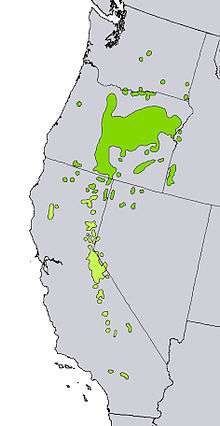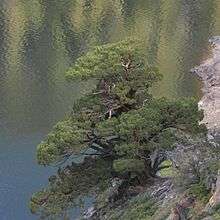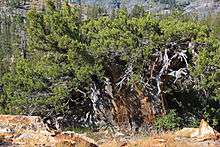Juniperus occidentalis
| Juniperus occidentalis | |
|---|---|
 | |
| Tree of var. occidentalis, Lava Beds National Monument | |
| Scientific classification | |
| Kingdom: | Plantae |
| Division: | Pinophyta |
| Class: | Pinopsida |
| Order: | Pinales |
| Family: | Cupressaceae |
| Genus: | Juniperus |
| Species: | J. occidentalis |
| Binomial name | |
| Juniperus occidentalis | |
 | |
| Natural range | |
Juniperus occidentalis (western juniper or Sierra juniper) is a shrub or tree native to the western United States, growing in mountains at altitudes of 800–3,000 metres (2,600–9,800 ft) and rarely down to 100 metres (330 ft).
Description
The Juniperus occidentalis shoots are of moderate thickness among junipers, 1-1.6 mm diameter. The leaves are arranged in opposite decussate pairs or whorls of three; the adult leaves are scale-like, 1–2 mm long (to 5 mm on lead shoots) and 1-1.5 mm broad. The juvenile leaves (on young seedlings only) are needle-like, 5–10 mm long. The cones are berry-like, 5–10 mm in diameter, blue-brown with a whitish waxy bloom, and contain one to three seeds; they are mature in about 18 months. The male cones are 2–4 mm long, and shed their pollen in early spring.
The cones are an important food for several birds, including American robin, Clark's nutcracker, phainopepla and cedar waxwing; these digest the fleshy cone scales and disperse the seeds in their droppings. The plants often bear galls caused by the juniper tip midge Oligotrophus betheli (Bibionomorpha: Cecidomyiidae); these are violet-purple fading to brown, 1–2 cm diameter, with dense modified spreading scale-leaves 6–10 mm long and 2–3 mm broad at the base.
Varieties

There are two Juniperus occidentalis varieties, treated as subspecies by some botanists:
- Juniperus occidentalis var. occidentalis Western Juniper. Southeast Washington, eastern and central Oregon, southwest Idaho, northeastern California and extreme northwest Nevada, north of 40° 30' N latitude, east of the Cascade Range. A shrub or small tree 4–15 m tall. Exceptionally tall specimens can be found in the John Day area of Oregon well in excess of 26–28 m (85–92 ft) tall where they compete for sunlight among ponderosa pines at the bottom of some deep side canyons. Howerver, on open and barren ground 4–15 m with a bushier growth habit is more common. Cones 7–10 mm diameter. About 50% of plants are monoecious with both sexes on the same plant, 50% dioecious, producing cones of only one sex.
- Juniperus occidentalis var. australis Sierra juniper. California and westernmost Nevada, south of 40° 30' N latitude in the Sierra Nevada and San Bernardino Mountains. A medium-sized tree 12–26 m tall with a stout trunk up to 3 m diameter. Cones 5–9 mm diameter. Most plants dioecious, but about 5–10% are monoecious.
Ancient tree
The Bennett Juniper in the Stanislaus National Forest of California is considered the oldest and largest example at possibly 3000 years old, with a height of 26 m and a diameter of 3.88 m.[2]
Habitat

Juniperus occidentalis usually occurs on dry, rocky sites where there is less competition from larger species like ponderosa pine and coast Douglas-fir. In very exposed positions at high altitude, they can assume a krummholz habit, growing low to the ground even when mature with a wide trunk. Hybrids with Juniperus osteosperma are occasionally found.
References
- ↑ Farjon, A. (2013). "Juniperus occidentalis". The IUCN Red List of Threatened Species. IUCN. 2013: e.T42242A2965783. doi:10.2305/IUCN.UK.2013-1.RLTS.T42242A2965783.en. Retrieved 15 December 2017.
- ↑ Conifers.org Australis
Further reading
- Adams, R. P. (2004). Junipers of the World: The genus Juniperus. Trafford Publishing ISBN 1-4120-4250-X
- Chase, J. Smeaton (1911). Cone-bearing Trees of the California Mountains. Chicago: A. C. McClurg & Co. p. 99. LCCN 11004975. OCLC 3477527. LCC QK495.C75 C4, with illustrations by Carl Eytel - Kurut, Gary F. (2009), "Carl Eytel: Southern California Desert Artist", California State Library Foundation, Bulletin No. 95, pp. 17-20 retrieved Nov. 13, 2011
- Conifer Specialist Group (1998). "Juniperus occidentalis". IUCN Red List of Threatened Species. Version 2006. International Union for Conservation of Nature. Retrieved 12 May 2006.
External links
| Wikimedia Commons has media related to: |
